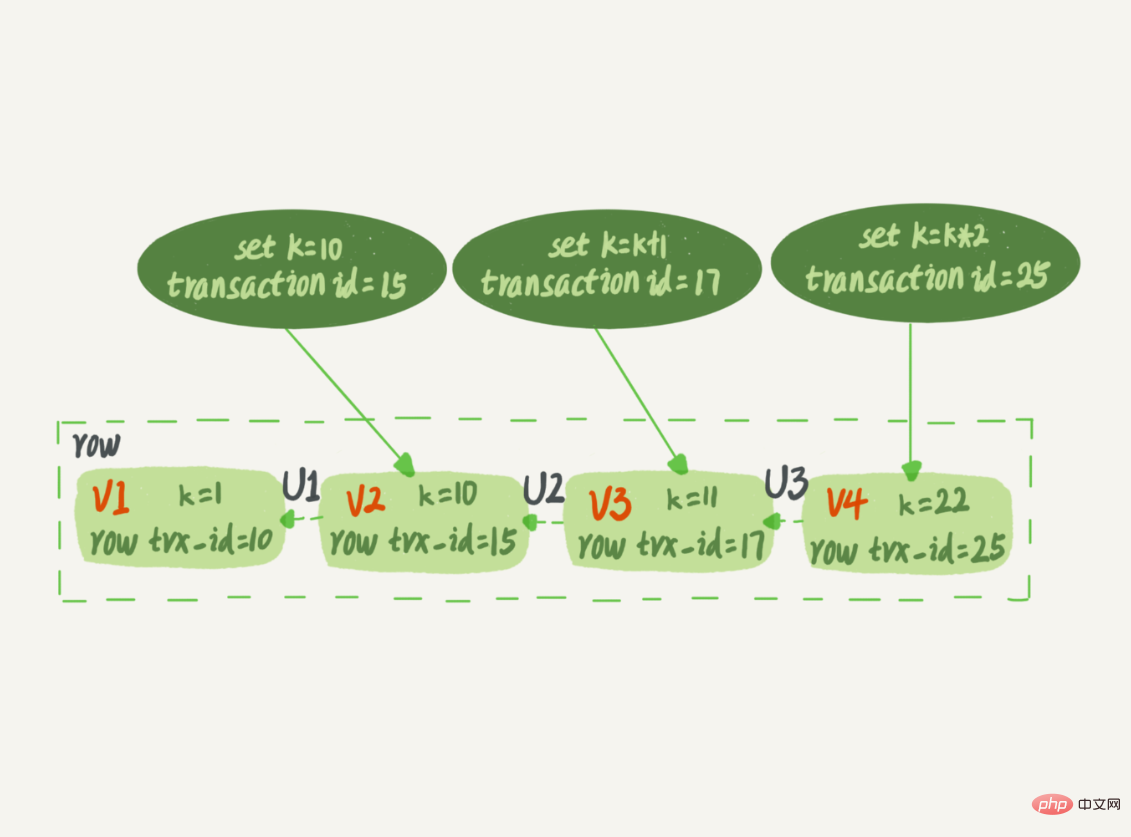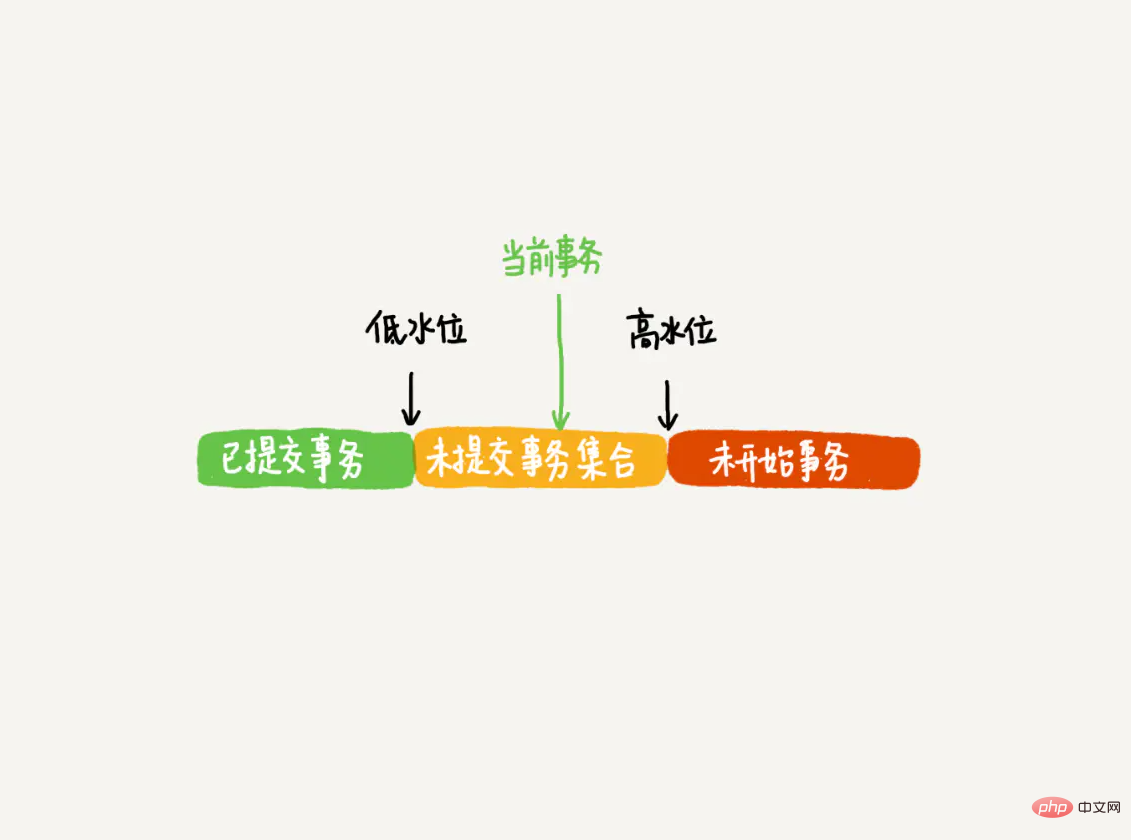Briefly analyze the snapshots in MVCC and see how snapshots work?
This article will take you to understand snapshots in MVCC and see how snapshots work in MVCC? Hope it can help everyone!

MVCC
In MySQL (innodb storage engine), in fact, each record will record a rollback operation at the same time when it is updated. The latest value on the record can be obtained by rolling back the value of the previous state.
Suppose a value is changed from 1 to 2, 3, and 4 in order, there will be a record similar to the following in the rollback log.

The current value is 4, but when querying this record, transactions started at different times will have different read-views. As you can see in the figure, in views A, B, and C, the values of this record are 1, 2, and 4 respectively. The same record can exist in multiple versions in the system, which is the multi-version concurrency control (MVCC) of the database. ). For read-view A, to get 1, the current value must be obtained by executing all the rollback operations in the figure.
How InnoDB defines a ‘snapshot’
Each transaction in InnoDB has a unique transaction ID, called transaction id. It is applied to the InnoDB transaction system at the beginning of the transaction, and is strictly incremented in the order of application.
And each row of data also has multiple versions. Every time a transaction updates data, a new data version will be generated, and transaction id will be assigned to the transaction ID of this data version, recorded as row trx_id. At the same time, the old data version should be retained, and in the new data version, there may be information that can be obtained directly.
In other words, a row of records in the data table may actually have multiple versions (row), and each version has its own row trx_id.

According to the definition of repeatable read, When a transaction is started, all submitted transaction results can be seen. But then, while this transaction is executing, updates from other transactions are not visible to it.
Therefore, a transaction only needs to declare when starting, "Based on the moment I start, if a data version is generated before I start, it will be recognized; if I start If it is generated later, I will not recognize it. I have to find its previous version." Of course, if the "previous version" is not visible either, you have to keep looking forward. Also, if the data is updated by the transaction itself, it still has to recognize it.
In terms of implementation, InnoDB constructs an array for each transaction to save all transaction IDs that are currently "active" at the moment the transaction is started. "Active" means that it has been started but has not yet been submitted.
The minimum value of the transaction ID in the array is recorded as the low water level, and the maximum value of the transaction ID that has been created in the current system plus 1 is recorded as the high water level.
This view array divides all row trx_id into several different situations.

In this way, for the startup moment of the current transaction, the row trx_id of a data version has the following possibilities:
If it falls in the green part, it means that this version is a submitted transaction or generated by the current transaction itself, and this data is visible;
If it falls in the red part, it means that this version It is generated by transactions started in the future and is definitely invisible;
If it falls in the yellow part, it includes two situations
a. If row trx_id is in the array, it means that this version is generated by a transaction that has not yet been submitted and is invisible;
b. If row trx_id is not in the array, it means that this version is a transaction that has been submitted. Generated, visible.
For example:
session A starts a transaction A. Before transaction A starts, there are three active transactions in the system, with IDs 90 93 95.
Then the ID of transaction A is 100
At this time, the view array for transaction A is like this [90 93 95 100], where the low water level is 90 and the high water level is 100 1=101;
Now the transaction A starts reading data
- If you read that the ID is 104, which is greater than the high water level of 101, it means that this version is generated by a transaction started in the future and is definitely invisible;
- Read that the ID is 88, which is less than the low water level of 90, means that this version is a submitted transaction or generated by the current transaction itself, and this data is visible;
- read that the ID is 94, which is between the low water level and the high water level. time, but is not in the array [90 93 95 100], it means that this version is generated by a transaction that has been submitted and is visible.
- I read that the ID is 93, which is between the low water level and the high water level. This [90 93 95 100] array indicates that this version is generated by a transaction that has not yet been submitted and is invisible;
This judgment rule is directly translated from the code logic, but as you can see, it is troublesome to use for human flesh analysis visibility.
So, let me translate it for you. For a data version, for a transaction view, in addition to its own updates being always visible, there are three situations:
The version is uncommitted and invisible;
The version has been submitted, but it was submitted after the view was created, so it is invisible; the
version has been submitted, and it was submitted before the view was created, so it is visible.
[Related recommendations: mysql video tutorial]
The above is the detailed content of Briefly analyze the snapshots in MVCC and see how snapshots work?. For more information, please follow other related articles on the PHP Chinese website!

Hot AI Tools

Undresser.AI Undress
AI-powered app for creating realistic nude photos

AI Clothes Remover
Online AI tool for removing clothes from photos.

Undress AI Tool
Undress images for free

Clothoff.io
AI clothes remover

Video Face Swap
Swap faces in any video effortlessly with our completely free AI face swap tool!

Hot Article

Hot Tools

Notepad++7.3.1
Easy-to-use and free code editor

SublimeText3 Chinese version
Chinese version, very easy to use

Zend Studio 13.0.1
Powerful PHP integrated development environment

Dreamweaver CS6
Visual web development tools

SublimeText3 Mac version
God-level code editing software (SublimeText3)

Hot Topics
 1386
1386
 52
52
 MySQL: Simple Concepts for Easy Learning
Apr 10, 2025 am 09:29 AM
MySQL: Simple Concepts for Easy Learning
Apr 10, 2025 am 09:29 AM
MySQL is an open source relational database management system. 1) Create database and tables: Use the CREATEDATABASE and CREATETABLE commands. 2) Basic operations: INSERT, UPDATE, DELETE and SELECT. 3) Advanced operations: JOIN, subquery and transaction processing. 4) Debugging skills: Check syntax, data type and permissions. 5) Optimization suggestions: Use indexes, avoid SELECT* and use transactions.
 How to open phpmyadmin
Apr 10, 2025 pm 10:51 PM
How to open phpmyadmin
Apr 10, 2025 pm 10:51 PM
You can open phpMyAdmin through the following steps: 1. Log in to the website control panel; 2. Find and click the phpMyAdmin icon; 3. Enter MySQL credentials; 4. Click "Login".
 MySQL: An Introduction to the World's Most Popular Database
Apr 12, 2025 am 12:18 AM
MySQL: An Introduction to the World's Most Popular Database
Apr 12, 2025 am 12:18 AM
MySQL is an open source relational database management system, mainly used to store and retrieve data quickly and reliably. Its working principle includes client requests, query resolution, execution of queries and return results. Examples of usage include creating tables, inserting and querying data, and advanced features such as JOIN operations. Common errors involve SQL syntax, data types, and permissions, and optimization suggestions include the use of indexes, optimized queries, and partitioning of tables.
 How to use single threaded redis
Apr 10, 2025 pm 07:12 PM
How to use single threaded redis
Apr 10, 2025 pm 07:12 PM
Redis uses a single threaded architecture to provide high performance, simplicity, and consistency. It utilizes I/O multiplexing, event loops, non-blocking I/O, and shared memory to improve concurrency, but with limitations of concurrency limitations, single point of failure, and unsuitable for write-intensive workloads.
 Why Use MySQL? Benefits and Advantages
Apr 12, 2025 am 12:17 AM
Why Use MySQL? Benefits and Advantages
Apr 12, 2025 am 12:17 AM
MySQL is chosen for its performance, reliability, ease of use, and community support. 1.MySQL provides efficient data storage and retrieval functions, supporting multiple data types and advanced query operations. 2. Adopt client-server architecture and multiple storage engines to support transaction and query optimization. 3. Easy to use, supports a variety of operating systems and programming languages. 4. Have strong community support and provide rich resources and solutions.
 MySQL's Place: Databases and Programming
Apr 13, 2025 am 12:18 AM
MySQL's Place: Databases and Programming
Apr 13, 2025 am 12:18 AM
MySQL's position in databases and programming is very important. It is an open source relational database management system that is widely used in various application scenarios. 1) MySQL provides efficient data storage, organization and retrieval functions, supporting Web, mobile and enterprise-level systems. 2) It uses a client-server architecture, supports multiple storage engines and index optimization. 3) Basic usages include creating tables and inserting data, and advanced usages involve multi-table JOINs and complex queries. 4) Frequently asked questions such as SQL syntax errors and performance issues can be debugged through the EXPLAIN command and slow query log. 5) Performance optimization methods include rational use of indexes, optimized query and use of caches. Best practices include using transactions and PreparedStatemen
 MySQL and SQL: Essential Skills for Developers
Apr 10, 2025 am 09:30 AM
MySQL and SQL: Essential Skills for Developers
Apr 10, 2025 am 09:30 AM
MySQL and SQL are essential skills for developers. 1.MySQL is an open source relational database management system, and SQL is the standard language used to manage and operate databases. 2.MySQL supports multiple storage engines through efficient data storage and retrieval functions, and SQL completes complex data operations through simple statements. 3. Examples of usage include basic queries and advanced queries, such as filtering and sorting by condition. 4. Common errors include syntax errors and performance issues, which can be optimized by checking SQL statements and using EXPLAIN commands. 5. Performance optimization techniques include using indexes, avoiding full table scanning, optimizing JOIN operations and improving code readability.
 Monitor Redis Droplet with Redis Exporter Service
Apr 10, 2025 pm 01:36 PM
Monitor Redis Droplet with Redis Exporter Service
Apr 10, 2025 pm 01:36 PM
Effective monitoring of Redis databases is critical to maintaining optimal performance, identifying potential bottlenecks, and ensuring overall system reliability. Redis Exporter Service is a powerful utility designed to monitor Redis databases using Prometheus. This tutorial will guide you through the complete setup and configuration of Redis Exporter Service, ensuring you seamlessly build monitoring solutions. By studying this tutorial, you will achieve fully operational monitoring settings




